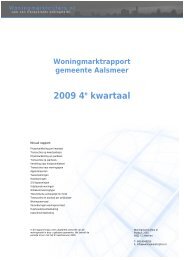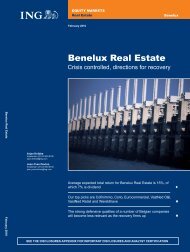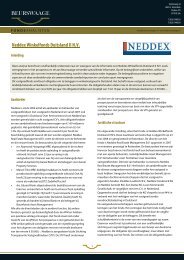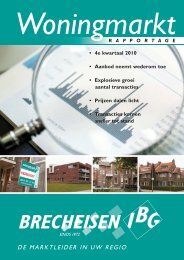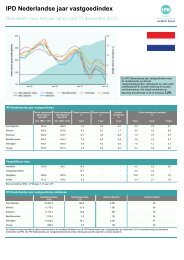Global Debt Sales survey 2012 - Vastgoedjournaal
Global Debt Sales survey 2012 - Vastgoedjournaal
Global Debt Sales survey 2012 - Vastgoedjournaal
You also want an ePaper? Increase the reach of your titles
YUMPU automatically turns print PDFs into web optimized ePapers that Google loves.
<strong>Global</strong> <strong>Debt</strong><strong>Sales</strong> <strong>survey</strong> <strong>2012</strong>Portfolio Solutions Groupkpmg.comLOAN PORTFOLIO ADVISORYKPMG INTERNATIONAL
CONTENTS2 GLOBAL DEBT SALES SURVEY © <strong>2012</strong> <strong>2012</strong> KPMG International Cooperative (“KPMG International”), a Swiss entity.
MARKET OVERVIEWBasel IIIIncreasing Tier 1 capital or decreasing RWAs?The key elements include:• increased capital ratios, with a focus on the need for good quality, loss-absorbing equity capital• increasing quality of capital requirements with a focus on harmonization across borders• new leverage requirements, effectively capping the absolute size of balance sheets in relation tocapital, irrespective of risk• new measures to improve counterparty risk management, focused on collateral managementand stress testing• new liquidity requirements to ensure firms hold sufficient high quality liquid assets to meetshort-term shocks, and to encourage a restructuring of the balance sheet with a focus onmatching of long-term funding sources against longer-term assets.With international capital markets effectively closed to new shareissuances and muted bank profitability, achieving the higher Tier 1 ratiothresholds will be assisted through RWA reduction. The conditions areripe for a considerable increase in the volume of deleveraging around theworld, but the urgency is greatest in Europe. Bank restructuring continuesapace and the deadline for banks to have a core Tier 1 capital ratio of 9percent under Basel III is fast approaching (see: Basel III: Increasing Tier 1capital or decreasing RWAs?, above). The International Monetary Fund’s(IMF) latest <strong>Global</strong> Financial Stability Report suggests that largeEU-based banks could shrink their combined balance sheet by as muchas US$2.6 trillion through end-2013, or almost 7 percent of total assets.“Our estimate is that about one-fourth of this deleveraging could occurthrough a reduction in lending, with the remainder coming largely fromsales of securities and non-core assets,” the IMF said. 2Achieving the targets of Basel III is by no means assured. Morgan Stanleyestimates that 11 of the 30 largest banks in Europe will not reach therequired 9 percent threshold by 2013, including Deutsche Bank, CreditAgricole, Unicredit and Lloyds Banking Group. 3 The bank noted that adeteriorating earnings outlook for European banks means that banks willhave more challenging organic capital builds to reach new capital ratios.“The European market has seen some notable transactions such asProject Isobel, in which the Royal Bank of Scotland reportedly sold a 25percent interest in a GBP1.36 billion portfolio of loans to Blackstone. Ina transaction that also closed in December 2011, Project Royal, LloydsBanking Group sold GBP900 million of non-performing loans to LoneStar. 4 But despite these headline-grabbing deals, the market has nottaken off to the extent that many participants expected,” says Stuart King,<strong>Global</strong> Co-Leader, KPMG’s Portfolio Solutions Group.2 IMF <strong>Global</strong> Financial Stability Report – The Quest forLasting Stability, April <strong>2012</strong>3 Morgan Stanley: European banks: What are the risksof €1.5-2.5trn deleveraging?, November 20114 CoStar News, December 7 2011, http://www.costar.co.uk/en/assets/news/2011/December/Lone-Star-wins-1bn-Project-Royal/© <strong>2012</strong> KPMG International Cooperative (“KPMG International”), a Swiss GLOBAL entity. DEBT SALES SURVEY <strong>2012</strong> 7
MARKET OVERVIEWAre LTROs a brake on sales?This is due in part to the EUR1 trillion of long-term refinancingoperations (LTROs) the European Central Bank (ECB) has pumpedinto the banking system. In a move of unprecedented scale, theECB injected EUR489 billion of cheap money on 21 December2011 and a further EUR530 billion on 29 February <strong>2012</strong>. Thislong-term refinancing of banks had an exceptionally longmaturity of three years (prior issues were matured within 18months), with an option of early repayment after one year asa fixed-rate tender at full allotment (see graphs, page 10).Europe’s banks gratefully accepted the cheap money –priced at 50 basis points for three years – and initiallydeposited the funds with the ECB. Some banks havealso used parts of the LTRO allocation to acquiresovereign debt, having the duel effect of pushingdown sovereign debt yields and boosting bank profitsthrough the spread created on the carry trade.“There is a general view that LTROs have reducedthe urgency of asset sales in the short term,”says Nick Colman, Director in the PortfolioSolutions Group at KPMG in Germany. “Thismay be the case for the very large portfolios oflong dated residential mortgages and projectfinance loans that they have sitting on theirbalance sheets, but we see a lot of saleactivity for stressed and NPL portfolioswhich are expensive from a capitalperspective and where value leakage forthe bank is a key concern.”LTROs were designed to stimulatebank lending to corporations and8 GLOBAL DEBT SALES SURVEY © <strong>2012</strong> <strong>2012</strong> KPMG International Cooperative (“KPMG International”), a Swiss entity.
MARKET OVERVIEWLTRO size and maturities600000500000400000300000200000100000LTRO size (€ m)Jan/10Jun/10Dec/10Jun/11Nov/11Apr/12120010008006004002000LTRO maturities (days)Jan/10Jun/10Dec/10Jun/11Nov/11Apr/12Source: European Parliament, 3-Year LTROs – A First Assessment of a Non-Standard Policy Measure, April <strong>2012</strong>“”Nick Colman, Director, Portfolio Solutions Group, KPMG in GermanyWe see a lot of sale activity for stressedand NPL portfolios which are expensive froma capital perspective and where value leakagefor the bank is a key concern.10 GLOBAL DEBT SALES SURVEY © <strong>2012</strong> <strong>2012</strong> KPMG International Cooperative (“KPMG International”), a Swiss entity.
MARKET OVERVIEW“Spain is the hottest distressed debtmarket right now – the pipeline is considerable.We would expect to see EUR10 to 15 billionof transactions in the next 12 months.Joel Eduard Grau Blasi, Director, Portfolio Solutions Group, KPMG in Spain”Banks’ creditworthiness questionedMore recently, the viability of banks has come to a head in Spain, whereMoody’s cut the ratings of sixteen Spanish banks on 17 May <strong>2012</strong>.Moody’s also cut the ratings of four of Spain’s regions – Catalonia, Murcia,Andalusia and Extremadura – saying they would be unlikely to meet the<strong>2012</strong> deficit target. Moody’s warned that rising borrowing costs wouldreduce Spain’s ability to provide support for its banks.Moody’s said there were four main drivers for the downgrades: firstly,adverse operating conditions characterized by the renewed recession.Next is the ongoing real-estate crisis and persistent high levels ofunemployment. Reduced creditworthiness of the Spanish sovereign,which weighs on banks’ standalone profiles and affects the ability of thegovernment to support banks, is a further factor. The final driver is rapidasset-quality deterioration, with non-performing loans to real-estatecompanies rising quickly. Moody’s expect other loan categories todeteriorate; and restrict market-funding access, with the ongoingEuro area debt crisis contributing to persistent investor concernsabout Spanish banks and the sovereign. 7The Moody’s announcement came just days before the Bankof Spain said that bad loans rose to 8.37 percent of all banks’outstanding loans, the highest level since August 1994. “In myopinion, Spain is the hottest distressed debt market in Europeright now – the pipeline is considerable. We would expect tosee EUR10 to 15 billion of transactions in the next year,” saysJoel Eduard Grau Blasi, Director in the Portfolio SolutionsGroup at KPMG in Spain. “Buyers and sellers are on thesame page now, with better understanding of the truevalue of loans and collateral. It is taking longer to closetransactions, as parties want deals where there is thepotential for profit sharing or deferring portions of thepayment, but everyone is open to these structures.”7 Moody’s Investor Services, 17 May <strong>2012</strong>, http://www.moodys.com/research/Moodys-downgrades-Spanish-banks-ratings-carry-negative-outlooks-or-remain--PR_245275?WT.mc_id=BankRatings<strong>2012</strong>© <strong>2012</strong> KPMG International Cooperative (“KPMG International”), a Swiss GLOBAL entity. DEBT SALES SURVEY <strong>2012</strong> 11
MARKET OVERVIEWIs leverage on the way back?With the availability of equity not a major issue, the availability and cost ofleverage is key to whether deals are able to close.“If anything, the cost of secured funding for the acquisition of performingloan portfolios has remained stable or even slightly improved on the backof banks re-entering the fray, as well as the emergence of new funders,including insurance companies,” says Philippe Tapernoux, Head ofFinancial Institutions <strong>Debt</strong> Advisory in the UK. A buyer concurs: “Bankshave slowly overcome their fears of secured funding. This is starting tobe reflected in the cost but not yet in the advance rate or maturity.”The funding cost often stays higher than the yield on assets and,with conservative assumptions, buyers must take on refinancingconditions in one, two or three years, meaning lower bid prices.The situation does not affect every buyer in the same manner.Traditional, longer-term performing mortgage portfolios targetedby private equity houses will be impacted with transactionsharder to close given the gap between loan yield versusfunding costs, and loan term versus available funding terms.On the other hand, strategic bank buyers have the ability touse retail deposits or covered bonds as an additional sourceof funding, and established buyers in areas where thereturns are higher, such as consumer NPLs, can also tapthe corporate high yield bond market. A recent exampleis debt purchaser Lowell’s GBP200 million issue atan annual interest rate of 10.75 percent with a 2019maturity in March <strong>2012</strong>. In the non performing CREdebt sale market, recent financing deals have beenat 600 basis points, which seems to effectively havebecome the benchmark price for such deals.“The cost of secured funding for theacquisition of performing loan portfolios hasremained stable or even improved as banksre-enter the fray and new funders emerge.Philippe Tapernoux, Head of Financial Institutions <strong>Debt</strong> Advisory, KPMG in the UK”12 GLOBAL DEBT SALES SURVEY © <strong>2012</strong> <strong>2012</strong> KPMG International Cooperative (“KPMG International”), a Swiss entity.
MARKET OVERVIEWAre new entrantsaggressive movers?A substantial number of US funds – notably Centerbridge, Baupost,Kennedy Wilson and DE Shaw & Co – have entered the market in Europein the last 2 years. The US market is very competitive, with returns beingsqueezed, prompting many funds to look beyond their home market.There are concerns that the aggressive pricing strategies adopted bysome funds, with target equity IRRs in the low-to-mid teens, will squeezeincumbents out of the market.In particular, we have seen a large focus from US investors on marketssuch as Spain and Ireland, where they have recently transacted forthe first time. Entering a new market doesn’t come without its risksand choosing the right servicing partners or anchor portfolio/platforminvestment is often critical for future success.“You have a new breed of hungry US investors chasing higher returnsthan they can achieve at home – and they are pricing the deals accordingly,”says Stuart King, <strong>Global</strong> Co-Leader of the Portfolio Solutions Group.In addition, we are seeing a number of large Australian performingresidential mortgage investors focusing their attention on Europe (mostnotably the UK and Ireland) looking for anchor portfolio/platforms fromwhich to grow their European presence. This has been evidenced byPepper Home Loans’ reported acquisition of a major US bank’s Irishresidential mortgage business.“”Stuart King, <strong>Global</strong> Co-Leader, KPMG’s Portfolio Solutions GroupYou have a new breed of hungry USinvestors chasing higher returns than theycan achieve at home – and they are pricingthe deals accordingly.© <strong>2012</strong> KPMG International Cooperative (“KPMG International”), a Swiss GLOBAL entity. DEBT SALES SURVEY <strong>2012</strong> 13
Assets comingto marketSpain, the UK, the US and Ireland continue to be viewed by bothsellers and buyers as the countries with the highest potential fordebt sale transactions globally. <strong>Sales</strong> will be driven by non-coredisposals by big European banks, who have as much as EUR2.5 trillionof deleveraging to undertake. 8 We estimate that over EUR600 billion ofNPLs are sitting with UK, Irish and Spanish banks alone.Recent high-profile transactions in Germany include DeutscheWohnen buying the 23,500-apartment German BauBeCon portfoliofor EUR1.24 billion from Barclays. Deutsche Wohnen said theenterprise value implies a multiple of 13 and a price of EUR814 persquare metre. The deal is the fourth largest residential portfoliotransaction in the country this year, following Patrizia’s acquisitionof the EUR1.4 billion LBBW housing portfolio, TAG’s takeover ofEUR1.1 billion DKB Immobilien and Cerberus purchasing theEUR1 billion Speymill portfolio. On the debt side, Lone Star’sacquisition of the Excalibur loans from Bundesbank remainsthe largest distressed deal of <strong>2012</strong> in Germany. Outside thistransaction, corporate debt deals continue to be done onan asset-by-asset basis at the behest of the bank workoutteams.The pressure for asset sales in Spain is growing, and wewould expect to see EUR10 to 15 billion of transactionsover the next 12 months. This will be driven in no smallpart by the creation of either a centralized SpanishBad Bank or the requirement of individual banks tocreate separate vehicles to house their exposuresto Commercial Real Estate (CRE) and developerloans. Current estimates put the total exposureof Spanish Banks to CRE at EUR350 billion. Themain sellers will be Spanish banks, particularlythose that have merged, and foreign banks8 Morgan Stanley: European banks: What are the risks of €1.5-2.5trn deleveraging?, November 201114 GLOBAL DEBT SALES SURVEY © <strong>2012</strong> <strong>2012</strong> KPMG International Cooperative (“KPMG International”), a Swiss entity.
ASSETS COMING TO MARKETPotential for acquisition of portfolioBuyer Highest Potential36% 27%Spain GermanySeller Highest Potential40%USASource: KPMG International, <strong>Global</strong> <strong>Debt</strong> <strong>Sales</strong> Survey <strong>2012</strong>36%UK26%18%UK33%selling non-core assets, with a continued flow of transactions in the next4 to 5 years. We have not yet seen evidence of strategic debt purchasersin the Spanish market, with the buyer community comprising mainlyhedge funds and private equity funds.In the UK, despite expectations falling short on occasion, the success ofRBS and Lloyds with closing recent CRE loan transactions has offeredencouragement for future transactions. As at the time of writing, Lloydsare marketing Project Harrogate, a GBP625 million non-performingproperty loan (NPL) portfolio, while another major Irish bank is marketinga granular UK commercial property loan portfolio with a reported nominalvalue of GBP397 million, known as Project Pivot.USA9% 8%Latin IrelandAmericaSpain17%Germany4%France10%Central &EasternEurope“Price, reputation, efficiency and certaintyof execution are key value drivers for portfoliosellers. An open dialogue can lead to solutionsfor more challenging non-core disposals.Justin D. Sulger, AnaCap Financial Partners LLP”© <strong>2012</strong> KPMG International Cooperative (“KPMG International”), a Swiss GLOBAL entity. DEBT SALES SURVEY <strong>2012</strong> 15
ASSETS COMING TO MARKETEmerging asset classesBuyer Highest potentialKEYNPL = Non Performing LoansPL = Performing Loans40%NPL –UnsecuredconsumerEmerging asset classesSeller Highest potential29%NPL – CRE9%PL –corporate9%NPL –residentialmortgage7%PL –unsecuredconsumer7%NPL – SME7%PL –residentialmortgage5%PL –transport4%PL –commercialreal estate36%NPL – CRESource: KPMG International, <strong>Global</strong> <strong>Debt</strong> <strong>Sales</strong> Survey <strong>2012</strong>Asset classes25%NPL –residentialmortgage25%PL –unsecuredconsumer20% 18%NPL –UnsecuredconsumerPL –commercialreal estateNon-performing unsecured consumer loans are seen as the most likelyasset class to come to market in <strong>2012</strong> by 56 percent of buyers, drivenby the relatively uniform write-off policy for banks throughout Europe.The market has been seeing an increase in the segment in Spain, the UKand Germany, and activity is expected to increase. Under IAS 39, oncean unsecured consumer loan has exceeded 90 days past due, it has tobe fully provided for. As a result, any amount that can be achieved from asale is P&L accretive.“We estimate that there will be a surge of non-performing consumerloans globally as banks look to clear their warehouses. Banks sellingmulti-billion Euro consumer NPL portfolios packaged with their servicingplatforms and sweetened with forward flow contracts will becomeincreasingly common,” says Jonathan Hunt, Associate Director in thePortfolio Solutions Group at KPMG in the UK. In terms of consumer NPLdebt sales, 2011 saw the UK consumer debt purchase market return to itspre-crisis levels at over GBP800 million of investment size, which equatesto approximately GBP8-10 billion of debt face value. Most consumer debt16 GLOBAL DEBT SALES SURVEY © <strong>2012</strong> <strong>2012</strong> KPMG International Cooperative (“KPMG International”), a Swiss entity.
ASSETS COMING TO MARKET“Banks selling multi-billion Euro consumerNPL portfolios packaged with their servicingplatforms and sweetened with forward flowcontracts will become increasingly common.Jonathan Hunt, Associate Director, Portfolio Solutions Group, KPMG in the UK”sellers who were <strong>survey</strong>ed expect the volume of debt sold in the UKsector to peak in Q4 <strong>2012</strong> or Q1 2013 before falling back by between10-20 percent as banks’ warehouses are cleared.However, while consumer debt has traditionally been the easiest assetto sell, banks are increasingly seeking to sell the different asset classes.Trepp LLC estimates the market for distressed CRE loans in Europe atUS$204.8 billion compared to US$121 billion at US banks. In the UK andEurope for example, over the past 6 months many vendors have focusedon the disposal of CRE backed and leveraged loans, along with residentialmortgage loans through both clean or structured trades.Further, increasingly more challenging and also longer dated assets,such as infrastructure finance, shipping and transport loans are also beingconsidered for sale. These are tough assets for banks to sell because theyare very large portfolios, with very low yields and long maturities, andmany are priced cheaply. Margins are so thin that it is difficult for buyersto make a return unless they buy at a discount.To put this in context, if an infrastructure or residential mortgage portfoliohas a spread over LIBOR of 150bps and a maturity of 20 years, a buyerwith an unlevered return requirement of 6 percent per annum wouldneed to pay no more than 50 to 70 percent of the principle balanceoutstanding to achieve the target return.The key issue for the market is therefore tenor, yield and creditquality. In the Private Finance Initiative (PFI) debt space forexample, subject to these criteria, several banks have successfullyengaged with both pension funds and insurers to sell non-coreloan portfolios. We see this trend continuing, as Solvency II,equity yields and greater flexibility by vendors drives innovationfrom new buyer types and geographies.At these discounts it is hard for banks to sell becauseassets are valued at close to par on their books and wouldtherefore result in substantial losses. “<strong>Sales</strong> of longer-termperforming loan portfolios will only be delayed because ofLTRO funding and the pricing gap,” says Hunt.Zach Lewy,Founder,Arrow <strong>Global</strong>“2011 and <strong>2012</strong>have seen a returnto high levels ofdebt sale activity inthe UK. Volumegrowth has beendriven by structuralfactors includingeconomic, operational,and accountingconsiderations. The nextfew years will likely see acontinuation of thisenhanced sales activity as theoverhang of assets createdbut not sold in the 2008 to2010 period come to marketcombined with creditors sellingmore debt and higher value debtin response to a UK debt salemarketplace with a better balanceof supply and demand.”© <strong>2012</strong> KPMG International Cooperative (“KPMG International”), a Swiss GLOBAL entity. DEBT SALES SURVEY <strong>2012</strong> 17
CompletingtransactionsOverwhelmingly, the reason for transactions failing to complete isthe bid-ask spread, cited by 73 percent of buyers and 75 percentof sellers. Buyers said sellers not sticking to the timetable orwithdrawing from the process was the principle reason deals failed tocomplete in 14 percent of cases, while current market turmoil affected12 percent of situations.We believe that the price expectation gap is starting to close and thatbuyers and sellers are now at least on the same page. In some cases,transactions are taking longer to close and need to be structured in a wayPotential for acquisition of portfolioBuyer73%Bid ask gap22%Other14%7%SPA terms and conditionsSeller withdrawing from the process ornot sticking to the timetable12%5% Inability to obtain financingCurrent market turmoilSeller75%Bid ask gap33%Other20%Currentmarketturmoil13%Buyer withdrawingfrom the processSource: KPMG International, <strong>Global</strong> <strong>Debt</strong> <strong>Sales</strong> Survey <strong>2012</strong>18 GLOBAL DEBT SALES SURVEY © <strong>2012</strong> <strong>2012</strong> KPMG International Cooperative (“KPMG International”), a Swiss entity.
COMPLETING TRANSACTIONS5%Of the transactions in this <strong>survey</strong> werecompleted with vendor financethat allows buyers and sellers to share the upside. Wealso expect to see an increase in vendor finance, whichin our <strong>survey</strong> accounted for just 5 percent of deals.There are regulatory constraints in some major marketsthat are blocking vendor-financed deals. In Spain, forexample, if a seller retains a 25 percent equity interestor provides vendor finance for 25 percent of the valuethen Banco de España will say that the risk has notbeen sufficiently reduced or eliminated and will notallow the assets to be deconsolidated from thevendor’s accounts.German buyer“Those banks which have beenreluctant to write-off bad debt andhave kept it on their balance sheetfor longer will come under pressureto clear out their books.”German consumer debt seller“Prices for consumer debt will not reach2006 levels but there is still plenty ofroom for upside. Prices should increaseuntil demand declines.”Spanish seller“In terms of secured loans the remainingprice gap will start to narrow, due to the newprovisions law which was passed this year, anddue to investors’ expectations on collateral priceevolutions being more in line with the sellers.”UK consumer debt seller“We have seen a shift from smaller ‘business asusual’ sales to balance sheet driven decisions, andwith this comes fewer, larger, structured sales.”© <strong>2012</strong> KPMG International Cooperative (“KPMG International”), a Swiss GLOBAL entity. DEBT SALES SURVEY <strong>2012</strong> 19
COMPLETING TRANSACTIONSWhat types of sales processes were undertaken?BuyerSeller55% 34% 11% 29% 59% 12%BilateralAuctionBilateral & AuctionBilateralAuctionBilateral & AuctionSource: KPMG International, <strong>Global</strong> <strong>Debt</strong> <strong>Sales</strong> Survey <strong>2012</strong><strong>Sales</strong> processesOur <strong>survey</strong> found that bilateral sales processes accounted for 48 percentof transactions, with 41 percent through auctions and 11 percent throughcombined processes. Not surprisingly, buyers reported an increased biastowards bilateral processes, with 55 percent of respondents saying theyhad completed a bilateral transaction. In addition, our <strong>survey</strong> found a highnumber of ‘single name’ credit sales occurring.What form was the acquisition(s)/disposal(s)?Buyer79% 21% 55% 45%Single namePortfolioSellerSingle namePortfolioSource: KPMG International, <strong>Global</strong> <strong>Debt</strong> <strong>Sales</strong> Survey <strong>2012</strong>20 GLOBAL DEBT SALES SURVEY © <strong>2012</strong> <strong>2012</strong> KPMG International Cooperative (“KPMG International”), a Swiss entity.
COMPLETING TRANSACTIONSBRIEFINGSTRUCTURING TRANSACTIONSIn the consumer debt sales market, with larger transaction sizes,innovative deal structuring mechanisms are becoming morecommon to help maximize transaction value.As portfolio sizes grow and investment sizes increase, the way dealsare structured becomes increasingly important. This can have asignificant positive impact on pricing even where these structuresare relatively short-term.Structured deals can take many forms from forward flows, jointventure/upside arrangements with assets transferred into specialpurpose vehicles, to price deferrals and post-deal price adjustmentagreements. Each of these structures can be mutually beneficial forseller and purchaser, which in turn can drive returns.Having said this, despite the keenness of some of the more advancedpurchasers to explore these deal structures with sellers, many of thedebt sales teams within the banks still have a preference to ‘keepdeals simple’ and focus on speed and ease of execution – perhapsleaving value on the table for both parties? The useful lessonsfrom CRE loans sales, such as RBS’s CRE loan portfolio sale toBlackstone (Project Isobel), could be transposed to other marketsand asset classes.© <strong>2012</strong> KPMG International Cooperative (“KPMG International”), a Swiss GLOBAL entity. DEBT SALES SURVEY <strong>2012</strong> 21
ReturnrequirementsReturn requirements on deals increased over the past year, with47 percent of buyer respondents saying they have increased theirtarget internal rates of return (IRRs) and 47 percent saying they hadnot changed. Investors interviewed said that increased turmoil in financialmarkets led to them seeing a higher return. One noted that developedmarkets were generating emerging-market-level returns, which meantthat they needed to add an even higher premium for investment, inemerging markets.“The funds we have were raised with a certain IRR hurdle and we arenot changing it. Our underwriting assumptions may get harder to reflectthe current turmoil,” said one buyer.IRRs vary across markets in line with risk. Germany is seen as alower risk market and best positioned to deal with any fallout from theEurozone, as opposed to Spain which is commanding a higher IRR fromdebt buyers in line with higher risk.We may be at an inflection point in terms of returns. The lack of supplyof assets in some markets is increasing competition for the transactionsthat are out there, so buyers will have to take a hit on the return if theyare to win the transaction. While in other markets such as Spain, Portugaland parts of Central and Eastern Europe, buyers are requiring higher andhigher returns to take on the uncertainty. This is best evidenced in theUK where the buyer market for residential NPLs is far greater than theavailable supply. The outcome has therefore been favorable for vendors,as buyer competition and low teen IRRs have driven pricing far higher.“Maturity defaults and foreign banksretrenching will create a German NPLopportunity larger than in the last cycle.Dr. Ruprecht Hellauer, Founder of Albulus Advisors Germany GmbH”22 GLOBAL DEBT SALES SURVEY © <strong>2012</strong> <strong>2012</strong> KPMG International Cooperative (“KPMG International”), a Swiss entity.
RETURN REQUIREMENTSDid your IRR requirements a) increase b) decrease or c) remain thesame in 2011 as compared to 2010?Buyers’ IRR RequirementsIncreasing47%6%Decreasing47%Remained the sameSource: KPMG International, <strong>2012</strong>Do you envisage your IRR requirements a) increasing b) decreasingc) remaining constant for <strong>2012</strong> as compared to 2011?Buyers’ IRR RequirementsIncreasing 19%Decreasing14%67%Remained the sameSource: KPMG International, <strong>2012</strong>© <strong>2012</strong> KPMG International Cooperative (“KPMG International”), a Swiss GLOBAL entity. DEBT SALES SURVEY <strong>2012</strong> 23
RETURN REQUIREMENTS“We are seeing buyers in the UK driftingtowards a low-teens IRR for ‘stressed’portfolios to get deals done and to feed theiracquisition and servicing machines.Andrew Jenke, Director, Portfolio Solutions Group, KPMG in the UK”The majority (67 percent of buyer respondents) said they did not expectto change their return requirements in <strong>2012</strong>, though there was a slightbias towards seeking a higher return, with 19 percent saying they wereseeking a higher return against 14 percent expecting a fall. “Significantcontinued volatility in financial markets through at least the first half of<strong>2012</strong> combined with continually increasing stock of assets offered for saleshould not create an environment where we would adjust yields down,”said one buyer.The main issue is whether the buyer is targeting performing or nonperformingassets, because the IRR is correlated to the risk. For example,on Project Royal, a portfolio of NPLs sold by Lloyds Banking Group,we understand that the target equity return of the buyer was reportedat around 18 percent, because of the perceived poor quality of theunderlying assets. On Project Isobel, Royal Bank of Scotland’s GBP1.36billion portfolio sale, the equity return was reported to be far lower,reflecting the higher overall quality of the borrowers.“We are seeing buyers in the UK drifting towards a low-teens IRR for‘stressed’ portfolios to get deals done and to feed their acquisitionand servicing machines,” says Andrew Jenke, Director in thePortfolio Solutions Group, KPMG in the UK.UK Buyer“Significant,continued volatilityin financial marketsthrough at least thefirst half of <strong>2012</strong>combined withcontinually increasingstock of assets offered forsale should not create anenvironment where wewould adjust yields down.”US Buyer“The funds we have wereraised with a certain IRR hurdleand we are not changing it.Our underwriting assumptionsmay get harder to reflect thecurrent turmoil.”24 GLOBAL DEBT SALES SURVEY © <strong>2012</strong> <strong>2012</strong> KPMG International Cooperative (“KPMG International”), a Swiss entity.
A globalperspectiveKPMG’s Portfolio Solutions Group is one of the world’s leading practices with aglobal footprint and specialists focused exclusively on key markets in Europe,Asia, Latin America and the US. Here members of the team analyze the keydevelopments in those markets.EUROPE Andrew JenkeDirector, Portfolio Solutions Group, KPMG in the UKEurope has certainly emerged as the key focus for thoseparties looking to take advantage of the recent credit andsovereign crises, and the bank deleveraging that has followed.Importantly, the deleveraging focus of European banks has verymuch been spread across different product types (such as CRE, PFIand residential mortgages), different geographies (from Australia toEcuador) and varying degrees of credit quality (from deeply distressed toinvestment grade).Deal activity, both for performing and non-performing loans, has been mostprevalent in Spain, the UK and Ireland, with over EUR600 billion of NPLson their balance sheets. Other markets continue to generate high profiletransactions and buyer interest, such as Portugal, Germany and Italy.Activity in the Spanish market has been steadily building for over 2 yearsnow, with the wave of primarily foreign private equity (e.g., Cerberus,Lone Star) and investment bank (e.g., Morgan Stanley, Deutsche Bank)buyers now having to compete with an increasingly sophisticated setof well funded servicing platforms. While the market rallied on theback of unsecured NPL transactions, real estate backed loan sales,both for residential and commercial, have become the focus for newforeign buyers stimulated by new provisioning rules, as shown by overEUR500 million of residential mortgage NPLs being sold within thefirst 6 months of <strong>2012</strong>. Going forward, we expect the Spanish marketto continue to grow as banks really begin to tackle their commercialreal estate loan challenges and established buyersseek to feed local,recently built, machines.Ireland is a relative newcomer to the debt sale market and for thisreason banks and investors don’t have five years worth of bid/ask© <strong>2012</strong> KPMG International Cooperative (“KPMG International”), a Swiss GLOBAL entity. DEBT SALES SURVEY <strong>2012</strong> 25
A GLOBAL PERSPECTIVEclosing experience to draw upon. Given the scale of the macroeconomicreal estate declines across the country, this has made transactionsextremely challenging without a very motivated and informed vendor.While a number of transactions have been seen in the market, those thathave closed have largely been as a result of foreign banks seeking to exitthe Irish market, such as Lloyds’s loan portfolio sales to two US investors,and a major US bank’s mortgage business sale to Pepper Home Loans,both in late 2011/<strong>2012</strong>. It is also worth remembering that the majority ofdisposals within Ireland thus far, have focused on both performing andnon-performing loans. Given the buyer community for these assets todate, little sign of strategic or long-term financial interest in Irish assetshas yet to emerge.The UK is a bifurcated market – we see a very competitive andincreasingly heated consumer NPL market where new overseas entrantsare competing with established private equity owned players (such asLowell, Arrow <strong>Global</strong>, Cabot Financial, etc.), with the result that pricingand dealflow are increasing. The key question will be whether thisbuyer audience and the existing debt sale practices of UK banks will besufficient to handle the quantum of consumer NPLs residing on bankbalance sheets. Beyond this we have the issue of non-core, particularlyCRE, Leveraged Buyout (LBO) and residential mortgage, assets residingon both local and foreign bank balance sheets. While a challengefor banks headquartered from London to Dublin to Johannesburg toMelbourne, the desire and the commercial rationale to dispose ofthese assets in the UK has thus far been limited, with one importantexception. Lloyds has actively sought to unwind non-core legacy loanbooks in the UK spanning unsecured NPLs, CRE and leveraged loans toprimarily private equity buyers. As other banks — notably IBRC (formerlyAnglo Irish Bank) — seek to follow, the question remains whether thisheralds the start of the great UK bank asset sell off that many have beenpredicting for 3 years.Finally, it is worth noting that despite its historical activity and centralrole in the 2008 credit crisis, German banks are currently under littlepressure to sell assets, despite ratings downgrades, because of theoverall strength of the economy and sovereign. There have beensome substantial transactions in the housing market, but few cases ofGerman banks selling German assets. Further, with a few exceptions,we do not expect a great deal of activity from foreign-owned banksdisposing of German assets to increase going forward.US$40bnThe sum Ireland’s ‘bad bank’Nama paid in 2009 for US$92billion of real-estate loans26 GLOBAL DEBT SALES SURVEY © <strong>2012</strong> <strong>2012</strong> KPMG International Cooperative (“KPMG International”), a Swiss entity.
A GLOBAL PERSPECTIVEASIA PACIFIC Frank JanikPartner, Portfolio Solutions Group, KPMG in ThailandBroadly speaking, the market for debt sales in Asia-Pacific canbe divided into two camps: the developed and the developingeconomies. Asia’s financial crisis precedes that of the west by adecade, so in terms of sales of loan portfolios the market has been activefor some time now and is to an extent mature. Central banks becamecognizant of the fact that non-performing loans on the balance sheets oftheir banks were increasing and brought in regulations to force banks toclean up their act. Regulations were passed in Taiwan, the Philippines,Thailand, Malaysia, and India to make asset sales more attractive and nowthere are a number of banks in the region that see debt sales as a wayof managing their problem loans. Korea has been an active market in thelast year and we have seen a number of unsecured credit card portfolioscoming out. However, it is a very domestic market and you need a localpresence or partner.Asia’s banks are relatively healthy and we are now seeing a reversal ofthe historic trend, with a lot of Asian money flowing into Europe and theUS. Asian money is targeting property and infrastructure assets to gain afoothold in new markets. Sovereign wealth funds have put aside billionsof dollars to invest in Europe, where they are focused on performingassets, particularly in strategically important sectors such as energy andfood production.Australia and Japan sit as standalone markets in the region and thepattern of asset sales is more comparable with Europe or the US andit is these countries where European banks have the majority of theirexposure to the region. Foreign banks are trying to exit portfolios thatare largely performing, non-core assets. We also expect to seeincreased activity from Australia’s second tier banks, who expandedinto property-based, project-finance-based lending which they did notreally have the expertise to manage and so are sitting on someproblematic portfolios.“Asian money is flowing intoEurope and the US, targeting propertyand infrastructure assets to gain afoothold in new markets.”© <strong>2012</strong> KPMG International Cooperative (“KPMG International”), a Swiss GLOBAL entity. DEBT SALES SURVEY <strong>2012</strong> 27
A GLOBAL PERSPECTIVELATIN AMERICA Nicolas MalagambaAssociate Director, Portfolio Solutions Group, KPMG in SpainBrazil is ripe for overseas investment. There are over US$100billion of non-performing loans, despite the fact that theeconomy has been performing well. Consumption has beenincreasing significantly, growing at more than 30 percent per annum andsome of the credit is of questionable quality. Local banks are startingto consider sales and US investors with captive platforms are the mainpotential buyers for those assets. US investors are starting to look back toBrazil because returns in the US are under pressure and they see Brazilas a country where they can achieve improved performance.The market also suffers from a lack of information regarding the loansand borrowers, particularly in relation to corporate loans. This negativelyaffects the pricing assumptions applied by investors, therefore generatingriskier scenarios, higher return expectations and creating pricing gaps.We have already seen some activity by local and regional investorswho are exploring structuring alternatives as a means of bridging thatexpectation gap.There is also an opportunity to invest in servicing platforms, which wouldlikely give an aggressive investor a higher return. Brazil is a massivecountry and very fragmented in the way it goes about collecting andservicing debts. We would expect the country to follow the pattern ofother markets, where collection companies start raising money to buythe debt they have been servicing and then there is consolidation intoa smaller number of more serious players with representation acrossthe major cities. Brazil is on the first stage of that journey, so it is a veryattractive market for an investor with tolerance for risk.Elsewhere in the region we are seeing signs of greater activity, thoughmarkets are not always favorable for overseas investors. In Chile, largebanks are considering exiting some non-performing loans and in Mexicothere has been sporadic trades of residential mortgages and unsecuredportfolios. We expect to see activity in that market in the near future.“Brazil is on the first stage of aconsolidation journey, so it is a veryattractive market for an investorwith tolerance for risk.28 GLOBAL DEBT SALES SURVEY <strong>2012</strong>”© <strong>2012</strong> KPMG International Cooperative (“KPMG International”), a Swiss entity.
A GLOBAL PERSPECTIVEUNITED STATES Hernan MagarinosDirector, Portfolio Solutions Group, KPMG in the USWhen IBRC (formerly Anglo Irish Bank) sold a very large US$9.5billion loan portfolio in a single transaction, we expected that saleto be an inflection point and a precursor to increased activity.Though the loan sales activity has picked up slightly, large portfoliotransactions have not materialized and we have only seen a handful oftransactions over US$200 million. However, every piece of analysis we dopoints to more activity in the coming months. According to Trepp, thereis as much as US$1.7 trillion of real estate loans coming due in the next5 years and as many as 50 percent of those are under water.The larger banks are better capitalized due to better access to capitalmarkets and therefore in a better position to sell loans. It is estimatedthat currently there could be up to 800 banks on FDIC’s ‘problem bankslist’. These banks typically are trading on very low amounts of capitalwith few prospects of raising new equity. Taking into account potentialwrite-offs, they are already at the point where they should be on FDIClists and/or should have been liquidated. These banks are trying to ‘extendand pretend’ but with new maturities coming due, something will haveto give. We believe there will be extra force for these banks to sell moreassets, using creative structures that will allow them to maintain aminimum capital level.Another factor that has slowed sales of non-performing loans was thederegulation in Troubled <strong>Debt</strong> Restructurings (TDRs), which has effectivelyallowed banks to re-classify loans as TDRs so long as they are able torestructure under ‘market conditions’. This could be making some banks’balance sheets look healthier than they really are. You would have to askwhether some of these TDRs are not just future NPLs.In terms of market activity, there is interest for both performing andnon-performing loans, which is a change from recent years when therewas limited buyers’ appetite for performing loans. Now we are seeinginterest from commercial banks to buy performing assets or financeother buyers’ acquisitions, whereas for non-performing loans the mainplayers are still the specialist funds.The main asset class in the market is CRE. There is appetite frombuyers for C&I (Commercial & Industrial) and PFI (Project Finance)loans, but since these assets are pretty stable most banks arereluctant to sell them.US$1.7trnReal estate loans coming duein the next five years in the US© <strong>2012</strong> KPMG International Cooperative (“KPMG International”), a Swiss GLOBAL entity. DEBT SALES SURVEY <strong>2012</strong> 29
About theresearchKPMG conducted an online <strong>survey</strong> of buyers and sellers of loanportfolios in Q1/Q2 <strong>2012</strong>. The <strong>survey</strong>, which was designed toidentify some of the trends in the global debt sales market,targeted buyers of loan portfolios, including strategic buyers, privateequity, investment banks and opportunity funds, and sellers, includingcommercial banks and other financial institutions. Representativesof 57 organizations completed the <strong>survey</strong>.Buyers and sellers were located in the UK,Germany, Spain and the US.Location Buyer30%GermanyLocation SellerGermany13%UK33% UK 38%25% Spain12% 18%31%SpainUSUSSource: KPMG International, <strong>Global</strong> <strong>Debt</strong> <strong>Sales</strong> Survey <strong>2012</strong>More than two-thirds (68 percent) of buyers had made an investmentin 2011, while a similar proportion of sellers (65 percent) had completeda transaction. Completed transactions covered a wide range of dealtypes and sizes, including commercial real estate, corporate, residentialmortgages, unsecured consumer and infrastructure finance, withtransaction portfolio book values ranging from EUR1 million to aroundEUR500 million.30 GLOBAL DEBT SALES SURVEY © <strong>2012</strong> <strong>2012</strong> KPMG International Cooperative (“KPMG International”), a Swiss entity.
GLOBAL DEBTSALES SURVEY <strong>2012</strong>For more information please contact:Jonathan Hunt,Associate Director, KPMG in the UKT: +44 7748 701 509E: jonathan.hunt@kpmg.com© <strong>2012</strong> KPMG International Cooperative (“KPMG International”), a Swiss GLOBAL entity. DEBT SALES SURVEY <strong>2012</strong> 31
ContactsPortfolio Solutions GroupGraham Martin<strong>Global</strong> Co-Leader, KPMG in the UKT: +44 78 2519 6802E: grahammartin@kpmg.comStuart King<strong>Global</strong> Co-Leader, KPMG in SpainT: +34 914 56 82 69E: stuartking@kpmg.comAndrew JenkeDirector, KPMG in the UKT: +44 7901 512 747E: andrew.jenke@kpmg.comJonathan HuntAssociate Director, KPMG in the UKT: +44 7748 701 509E: jonathan.hunt@kpmg.comMichal KozubkiewiczManager, KPMG in the UKT: +44 7786 664 949E: michal.kozubkiewicz@kpmg.co.ukSundeep LakhtariaManager, KPMG in the UKT: +44 7795 812 518E: sundeep.lakhtaria@kpmg.co.ukNick ColmanDirector, KPMG in GermanyT: +49 17 3541 8596E: ncolman@kpmg.comJoel Eduard Grau BlasiDirector, KPMG in SpainT: +34 639 92 65 09E: joelgrau@kpmg.esNicolas MalagambaAssociate Director, KPMG in SpainT: +44 7197 132 969E: nicolas.malagamba@kpmg.comBruno PerriManager, KPMG in SpainT: +34 616 71 37 49E: bperri@kpmg.comHernan MagarinosDirector, KPMG in the UST: +1 917 656 6042E: hmagarinos@kpmg.comSudhi JoshiVice President, KPMG in the UST: +1 607 592 6258E: sjoshi@kpmg.comFrank JanikPartner, KPMG in ThailandT: +66 81 869 6522E: fjanik@kpmg.comDavid WhiteDirector, KPMG in ThailandT: +66 2 677 2682E: dwhite8@kpmg.comkpmg.comThe information contained herein is of a general nature and is not intended to address the circumstances of any particular individual or entity.Although we endeavor to provide accurate and timely information, there can be no guarantee that such information is accurate as of the date itis received or that it will continue to be accurate in the future. No one should act on such information without appropriate professional adviceafter a thorough examination of the particular situation.© <strong>2012</strong> KPMG International Cooperative (“KPMG International”), a Swiss entity. Member firms of the KPMG network of independent firms areaffiliated with KPMG International. KPMG International provides no client services. No member firm has any authority to obligate or bind KPMGInternational or any other member firm vis-à-vis third parties, nor does KPMG International have any such authority to obligate or bind anymember firm. All rights reserved. Printed with KPMG International.The KPMG name, logo and “cutting through complexity” are registered trademarks or trademarks of KPMG International.Designed by Haymarket Network Ltd.Publication name: <strong>Global</strong> <strong>Debt</strong> <strong>Sales</strong> <strong>survey</strong> <strong>2012</strong>Publication number: 120756Publication date: July <strong>2012</strong>



